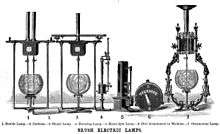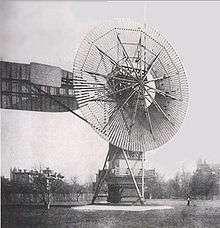Charles F. Brush
| Charles Francis Brush | |
|---|---|
 | |
| Born |
March 17, 1849 Euclid, Ohio |
| Died |
June 15, 1929 (aged 80) Cleveland, Ohio |
| Alma mater | University of Michigan |
| Known for | Arc lamp |
| Influences | Humphry Davy; Zénobe Gramme; Antonio Pacinotti |
| Notable awards |
Edison Medal (1913) Rumford Prize French Legion of Honor Franklin Medal |
|
Signature | |
Charles Francis Brush (March 17, 1849 – June 15, 1929) was an American inventor, entrepreneur and philanthropist.[1]
Biography
Born in Euclid Township, Ohio, Brush was raised on a farm about 10 miles from downtown Cleveland. He had a great interest in science, particularly with Humphry Davy's experiments with the arc light; he tinkered with and built simple electrical devices such as a static electricity machine at age 12, experimenting in a workshop on his parents' farm. Brush attended Central High School in Cleveland where he built his first arc light, and graduated there with honors in 1867.[2] His high school commencement oration was on the "Conservation of Force".[3] He received his college education from the University of Michigan, where he studied mining engineering (there were no majors—as there are today—in electrical engineering). At Michigan, Brush was a member of Delta Kappa Epsilon fraternity (Omicron chapter).
In 1876 he secured the backing of the Wetting Supply Company in Cleveland to design his "dynamo" (an electrical generator) for powering arc lights. Brush began with the dynamo design of Zénobe Gramme but his final design was a marked divergence, retaining the ring armature idea that originated with Antonio Pacinotti. Brush remarked on his motivation for improving the generator in his U.S. Patent 189,997: "The best forms of magneto-electric apparatus at present before the public are unnecessarily bulky, heavy, and expensive, and are more or less wasteful of mechanical power." After comparing it to the Gramme dynamo and other European entrants, the Franklin Institute of Philadelphia judged Brush's dynamo superior due to its simpler design and maintainability after completing tests in 1878.[4]
Brush produced additional patents refining the design of his arc lights in the coming years and sold systems to several cities for public lighting, and even equipped Philadelphia's Wanamaker's Grand Depot with a system.[5] His lights were easier to maintain, had automatic functions and burned twice as long as Yablochkov candles. His generators were reliable and automatically increased voltage with greater load while keeping current constant.[6] By 1881, New York, Boston, Philadelphia, Baltimore, Montreal, Buffalo, San Francisco, Cleveland and other cities had Brush arc light systems, producing public light well into the 20th century.[4]

 |
| New York central power plant dynamos powered arc lamps for public lighting. Beginning operation in December 1880 at 133 West Twenty-Fifth Street, it powered a 2 mile long circuit.[7] |
The San Francisco system was the first case of a utility selling electricity from a central plant to multiple customers via transmission lines.[6] The California Electric Light Company (now PG&E)[8][9] purchased two generators from Charles Brush's company in 1879 and soon opened a second plant with four additional generators. Service charges for light from sundown to midnight was $10 per lamp per six day week.[10] Brush's system was lighting Broadway two years before Edison's Pearl Street Station began lighting New York.[4] By 1893 there were 1500 arc lights illuminating New York streets.[11]
In 1879, the Anglo-American Brush Electric Light Corporation, using Brush's inventions, was formed in Lambeth, London, England. This company eventually moved to Loughborough England and became Brush Electrical Engineering Co. Ltd.
In 1880, Brush established the Brush Electric Company in the U.S. and, though successful, faced stiff competition from Thomson-Houston Electric Company, whose arc lights could be independently turned off, and by Edison, whose incandescent lights had a softer warm glow, didn't flicker and were less costly to maintain than arc lights. In 1882, the Brush Electric Company supplied generating equipment for a hydroelectric power plant at St. Anthony Falls in Minneapolis, among the first to generate electricity from water power in the United States. Thomson-Houston bought out Brush in 1889 and eventually merged to become part of General Electric in 1891. After selling his interests in Brush Electric, Brush never returned to the electric industry.
In 1884, Brush built a mansion on Euclid Avenue in Cleveland that showcased many of his inventions. There he raised his family and lived the remainder of his life. The basement housed Brush's private laboratory.[14] In 1888, he powered the mansion with the world's first automatically operated wind turbine generator which charged the home's 12 batteries. It was the first home in Cleveland to have electricity.[14] Over its 20-year life, the turbine never failed to keep the home continuously powered.[12] In 1926, Brush pioneered the first piezo-electric featherweight stylus.[15]
In 1898, Brush claimed to have discovered a new gas, which he named etherion. This gas had remarkable properties, being 10,000 times lighter than hydrogen and conducting heat 20 times faster than it.[16] In 1900, Marian Smoluchowski identified the gas as water vapor.[17]
Between 1910 and 1929 he wrote several papers on his version of a kinetic theory of gravitation, based on some sort of electromagnetic waves.
He died on June 15, 1929 in Cleveland, Ohio.[1]
Legacy
- Charles F. Brush High School in Lyndhurst, Ohio is named after Brush, whose sports teams and other groups are named the "Arcs," after Brush's lamp.
- Metro Parks, Serving Summit County's Furnace Run Metro Park in Richfield, Ohio, received a donation of land from the Family of Charles F. Brush. The donated tract is known as Brushwood.
- USS Brush (DD-745) 1943-1969 (then Taiwan's Hsiang Yang until scrapped in 1993) was named after Brush, sponsored by his great-granddaughter.[18]
Honors
- Rumford Prize of the American Academy of Arts and Sciences (1899)
- French Legion of Honor (1881)
- Edison Medal (1913)
- Franklin Medal
- Fellow of the North British Academy of Arts
Patents
- Generator (MAGNETO ELECTRIC MACHINE) 1877 U.S. Patent 189,997
- Arc light (automatic control of spark gap) 1878 U.S. Patent 203,411
- Arc light (double-carbon lamp regulation system) 1879 U.S. Patent 219,208
- Arc light (Automatic shut off for Electric Lights or Motors) 1880 U.S. Patent 234,456
- Arc light (improved regulator for the carbon arc) 1885 U.S. Patent 312,184
References
| Wikimedia Commons has media related to Charles F. Brush. |
- 1 2 "Charles F. Brush, Scientist, Dead. Inventor of Arc Light, 80 Years Old, Succumbs at Home in Cleveland. He Established Foundation for the Betterment of Man, Was Active in Philosophical Society". The New York Times. June 16, 1929. Retrieved 2015-10-26.
- ↑ La Favre, Jeffrey (1998). "Charles Brush and the Arc Light". Retrieved 2015-10-26.
- ↑ Freeberg, Ernest (2013). The Age of Edision. The Penguin Press. ISBN 978-1-59420-426-5.
- 1 2 3 "Charles Francis Brush". Hebrew University of Jerusalem. 2003-04-11. Archived from the original on 2009-02-24. Retrieved 2015-10-26.
- ↑ Charles William Calhoun (2006), The Gilded Age, Rowman & Littlefield, p. 40, ISBN 0-7425-5038-9, retrieved 2009-01-04
- 1 2 Kirby, Richard Shelton; Davis, Frances A. (1990), Engineering in History, Courier Dover Publications, p. 358, ISBN 0-486-26412-2, retrieved 2009-01-04
- ↑ Gorman, Mel. "Charles F. Brush and the First Public Electric Street Lighting System in America". Ohio History. 70: 142. Retrieved 2011-09-10.
- ↑ Supreme Court of California (1905), "California Electric Light Company v. California Safe Deposit & Trust Co. et al.", The Pacific reporter, 78, West Pub. Co, pp. 372–376
Note legal title. Roe, born circa 1852, died December 10, 1894. - ↑ Roth, Charles B. (19 December 2009). "PG&E of California, The centenial [sic] story of pacific gas and electric company 1852-1952". electrifications.net. Archived from the original on 23 July 2011. Retrieved 30 June 2010.
"In June 1879 [young Canadian broker] Roe [and other investors] incorporated the California Electric Light Co., he serving as secretary and manager. J. R. Hardenbergh was the first president.... In July 1880 PIERRE B. CORNWALL was elected vice president and treasurer. Next year he became president..." - ↑ PG&E passage no longer available quoted in blog, PG&E: Our History, retrieved 2009-01-04,
At 27, George Roe had founded the first electric company in the PG&E family tree. By September [1879] a little building at Fourth and Market was completed and two tiny Brush arc-light dynamos were installed. Together they could supply 21 lights. Customers were lured by the unabashed offer of service from sundown to midnight (Sundays and holidays excluded) for $10 per lamp per week. Yet in light-hungry San Francisco, customers came clamoring. By the first of the next year, four more generators with capacity of more than 100 lights had been added. Electricity had come to the West.
- ↑ Dennis, Richard (2008). Cities in Modernity: Representations and Productions of Metropolitan Space, 1840-1930. Cambridge University Press. p. 132. ISBN 0-521-46470-6. Retrieved 2015-10-26.
- 1 2 A Wind Energy Pioneer: Charles F. Brush, Danish Wind Industry Association, archived from the original on September 8, 2008, retrieved 2008-12-28
- ↑ Righter, Robert W. (1996). Wind Energy in America: A History. University of Oklahoma Press. p. 44. ISBN 978-0-8061-2812-2. Retrieved 2011-09-10.
- 1 2 Jeffrey La Favre, Brush mansion and family life, retrieved 2009-03-07
- ↑ Steven Schoenherr, Electrical recording replaces acoustic, archived from the original on 2009-07-20, retrieved 2009-07-23
- ↑ "New Gas a Wonder". Mariposa Gazette. Mariposa, CA. December 17, 1898. Retrieved 15 November 2015.
- ↑ Fontani, Marco; Costa, Mariagrazia; Orna, Mary Virginia (2014). The Lost Elements: The Periodic Table's Shadow Side. Oxford University Press. p. 424. ISBN 9780199383344.
- ↑ "DANFS entry on USS Brush". History.navy.mil. Archived from the original on December 6, 2013. Retrieved 2015-10-26.
